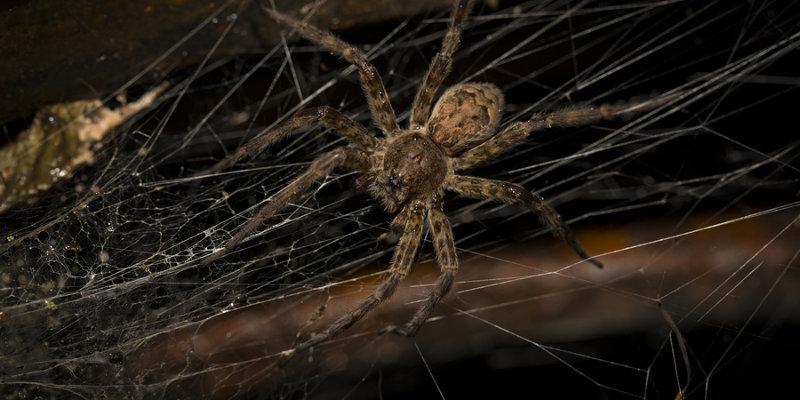There are several genera of wolf spider, ranging in size from 1 cm to 8 cm. They have eight eyes arranged in three rows. The bottom row consists of four small eyes, the middle row has two very large eyes (which distinguishes them from the Pisauridae), and the top row has two medium-sized eyes. They depend on their eyesight, which is quite good, to hunt. Their sense of touch is also acute. They are harmless to humans; a bite may cause some itching, but is itself nothing major.

- Wolf spiders are members of the family Lycosidae, from the Greek word “lycosa” meaning “wolf”. Their method of hunting is to run down their prey. They are robust and agile hunters that rely on good eyesight.
- Wolf spiders are unique in carrying their eggs along with them in a round silken globe, or egg sac, which they attach to the spinnerettes at the end of their abdomen. The abdomen must be held in a raised position to keep the egg case from dragging on the ground, but they are still capable of hunting while so encumbered. Also unique among spiders is their method of infant care. Immediately after the little spiders hatch and emerge from their protective silken case they clamber up their mother’s legs and all crowd onto her abdomen.
- Their eyes reflect light well, and one way of finding them is to hunt at night using a flashlight strapped to one’s forehead so that the light from the flashlight is reflected from their eyes directly back toward its source.
- Because they depend on camouflage for protection, they do not have the flashy appearance of some other kinds of spiders. In general their coloration is appropriate to their favorite habitat.
- Hogna is the genus with the largest of the wolf spiders. Among the Hogna species in the U.S., the nearly solid dark brown H. carolinensis is the largest, with a body that can be more than one inch long. It is sometimes confused with H. helluo (pictured below), which is somewhat smaller and entirely different in coloration.
- Some members of the Lycosidae, such as H. carolinensis (called the Carolina wolf spider despite the fact that its range covers much of the U.S.) make deep tubular burrows in and around which they lurk much of the time. Others, such as H. helluo, seek shelter under convenient rocks and other such shelters as nature may provide. They may wander from place to place, and are therefore more likely to be the ones attracted into human habitation when the weather starts to turn colder in autumn.
- There are many smaller wolf spiders. They patrol pastures and fields and are an important natural control on harmful insects.
- The wolf spiders are capable of giving defensive bites, and some South American species may give bites that are medically significant. However, in general their presence works very much in favor of humans wherever they are found.
- Wolf spiders are not aggressive but will inject venom freely if continually provoked. Symptoms of their venomous bite include swelling, mild pain and itching. Though usually considered harmless to humans, the bite of some species may be painful. In the past, necrotic bites have been attributed to some South American species, but further investigation has indicated that those problems that did occur were probably actually due to bites by members of other genera.[1] Australian wolf spiders have also been associated with necrotic wounds, but careful study has likewise shown them not to produce such results.[2]
At Longhorn Termite & Pest Control, we get rid of wolf spiders for customers in Azle, Weatherford, Benbrook, and Graham, Texas.
